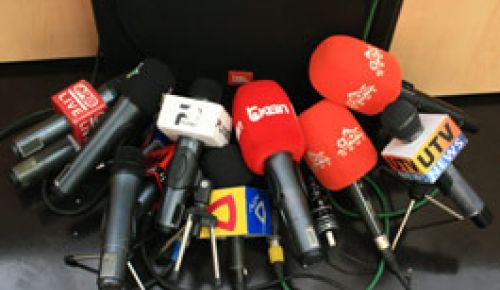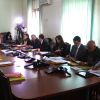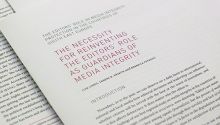Regulatory authorities at the usual crossroads?!
- The governing bodies of public broadcasters are operating without a confidence vote in view of the lack of re-election of Steering Council members, while the regulator sometimes struggles to meet the quorum for certain decisions.
The rotation of power after June 2013 elections in Albania brought once more to the fore the debate on election of the media regulatory authorities (1). With the new parliament swearing in on September, one of the first tasks of the Parliamentary Media Commission was to issue a call for proposals for new members of the Audiovisual Media Authority and the Steering Council of the public broadcaster. The mandate of all 11 members of the Steering Council has been over for at least a year now. “Apart from being a politicized and non-professional institution, currently RTSH is in an illegal moment, due to the expiry of mandates of members of the Steering Council, of the Administration Board, and of the General Director,” (2) stated Alfred Peza, Member of Parliament from the ruling Socialist Party and deputy head of the Parliamentary Media Commission. The regulator of audiovisual media has one member with an expired mandate, while there are two vacancies, which were not filled as the then-opposition had not nominated candidates for the post as part of the political decisions it had made at the time. While this should be a routine process, the application of a recently approved law has led to some controversies and debates on several aspects.
Appointment procedures and political dependence
The Law “On Audiovisual Media” was adopted in March 2013, after more than six years of discussion, revision, redrafting and consultation with experts and stakeholders. The final version of the law brought before parliament was a product of agreement between both political wings, with the exception of the formula on election of the regulatory authority and the Steering Council of the public broadcaster. Failing to reach consensus, the then-ruling majority’s proposal of the formula passed only with majority votes
(3). The inability to agree on a crucial matter of media regulation warns of the expected battle ahead on this issue in the future.
The law
(4) stipulates that the members should be professionals from different fields relevant to the regulators, nominated by professional associations, four proposals for each post. The opposition and the ruling majority MPs then in the Parliamentary Media Commission take turns in eliminating candidates for each vacant post, who then are shortlisted and sent to the plenary session for voting. This formula is supposed to ensure political balance between proposals of the ruling majority and opposition. While this might be a politically balanced formula, it does not solve a dilemma that has existed for almost fifteen years now: would we rather have a politically balanced regulator or a professional one? Is it possible to have both?
- As long as the election of members and chairs of the regulators remains dependent on, filtered by, and determined by parliamentary seats, the chances for more independent, autonomous and stronger regulatory bodies are slim.
Both political wings agreed to this manner of nominating and electing members of the regulators, indicating again their preference for a politically-balanced regulator, rather than a professional one. However, they could not agree on the manner of election of the head of the regulators, as both these bodies have an odd number of members. Finally, the ruling majority’s version passed, stating that the chair of AMA will be elected with a simple majority of votes, while the opposition MPs had demanded to elect the chair through consensus. This means that the head of the regulator will be again linked to the map of seats in parliament, as he/she will be elected through simple majority votes, with no mandatory need for consensus or any other kind of broader representation. The same is valid for the chair of the Steering Council of RTSH
(5). Hence, the chairs of both bodies will be again linked to the political factions in the country that propose and elect them. “The appointment procedure for members of the media regulatory authority – Audiovisual Media Authority (AMA), provided for by the law, does not fully guarantee their independence.”
(6)
Challenges to the application of the appointment formula in the current media landscape
Apart from the long-term effect of preserving this manner of appointment of members of regulators, at the moment the controversy of the process lies in the expressed intent of the ruling majority to change the head of AMA. While the matter of the public broadcaster and its Steering Council is clear, as the mandates of all members and chairman have expired, the situation with AMA is more complicated. The mandate of the current head of AMA has not expired. Furthermore, the head of AMA is elected through a separate mandate; after all other members have been elected
(7). In addition, the current law contains an article that states that the chairwoman and the members of the current council will hold their positions until their mandates expire
(8). In the current council, both the chairwoman and her deputy belong now to the opposition, which the current ruling majority has deemed unacceptable. However, they have also conceded the lack of clarity of provisions in the law on this matter, stating that there was a need for legal interpretation for this unacceptable situation
(9) . Meanwhile, the deputy chair of AMA resigned from the post of deputy chair, while claiming he would still serve as a simple member, in order to find a solution to the lack of balance created by this situation
(10). The issue is still pending, though, as the ruling majority claims that with this law, and the formula that the current opposition insisted to have on the books several months ago, the chair of the regulator should belong to the party that has most seats in parliament.
Ramifications for the future
The solution to the completion of the regulatory bodies is a matter of some urgency, in view of several delayed processes pending on the completion of these bodies. The governing bodies of public broadcasters are operating without a confidence vote in view of the lack of re-election of Steering Council members, while the regulator sometimes struggles to meet the quorum for certain decisions. In view of the imminent digital switchover, where AMA has to carry on the licensing process and RTSH to start to urgently build digital networks, the completion of these bodies and start of work is imperative.
In the very near future the Steering Council of RTSH is expected to be fully renewed, as the deadline for submitting applications is November 15. In addition, missing members of AMA will be nominated, enabling the full functioning of the body. However, the immediate controversy is expected to focus on the position of the chair of AMA, entering a battle of legal interpretations as to which party is entitled to the position: will it be a strict interpretation of the formula contained in the law [who has the highest number of votes also gets the chair of AMA] or will the transitory dispositions in the law prevail, allowing the current chairwoman to finish her mandate? The distribution of seats in parliament and the chronic dissatisfaction of the current ruling party with the work of the current chairwoman tip the balance to a clean slate for the regulator.
However, in the longer term, the real concern will be that a truly functioning formula for regulators has not yet been found. As long as the election of members and chairs of the regulators remains dependent on, filtered by, and determined by parliamentary seats, the chances for more independent, autonomous and stronger regulatory bodies are slim. While these formulas may contribute to balanced decisions, it is not necessarily guaranteed that balanced decisions are the right decisions. In addition, as the past has shown, political trust and consensus in the country run low, which means that the ruling majority will always have an upper hand due to the application of this formula, and that the link between politics and the regulator has not been severed. More importantly, the persistence of using these appointment procedures for years has focused public attention and debate on this matter, rarely going beyond the real work, problems, and challenges of the regulator, linking every act to politics, rather than to a deeper view of what the state of matters is and what can be done to improve it.
Notes:
(1) More specifically, the Authority on Audiovisual Media supervises the implementation of the law by audiovisual media operators, while the Steering Council of the Albanian Radio and Television (RTSH) is the highest governing body of the public broadcaster.
(2) A. Hoxha, “Kuvendi vendos emrat e rinj ne AMA e RTSH,” Shqiptarja.com, 16 October 2013.
(3) AMI, Albanian Media Newsletter, http://institutemedia.org/newsletter.html#march, March 2013.
(4) Law 97/2013, “On Audiovisual Media,” Art. 9.
(5) Law 97/2013, “On Audiovisual Media,” Art. 95.
(6) EU Progress Report on Albania, 2013,
(7) Law 97/2013, “On Audiovisual Media,” Art. 10.
(8) Ibid, Art. 134.
(9) A. Hoxha, “Kuvendi vendos emrat e rinj ne AMA e RTSH,” Shqiptarja.com, 16 October 2013.
(10) AMA press release, 28 October 2013, http://ama.gov.al/index.php?option=com_content&view=article&id=314%3Anjo...
 The appointment procedure for members of the media regulatory authority does not fully guarantee their independence.
The appointment procedure for members of the media regulatory authority does not fully guarantee their independence.






